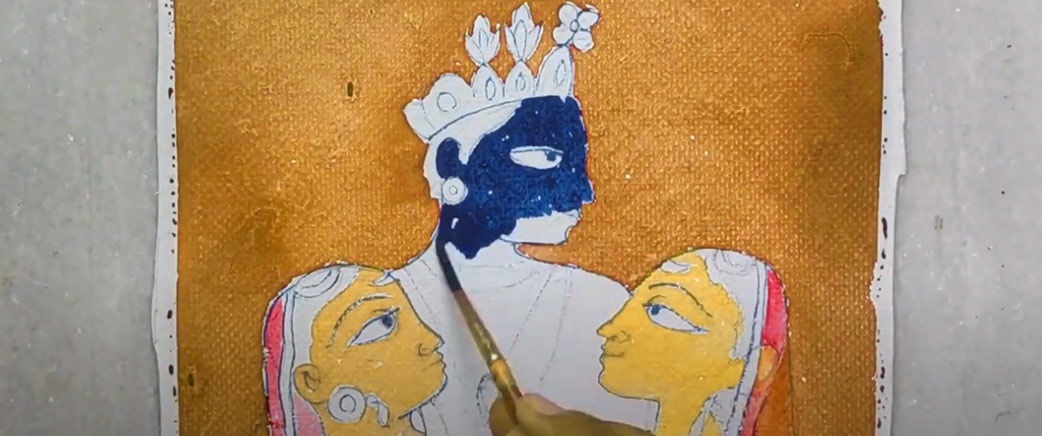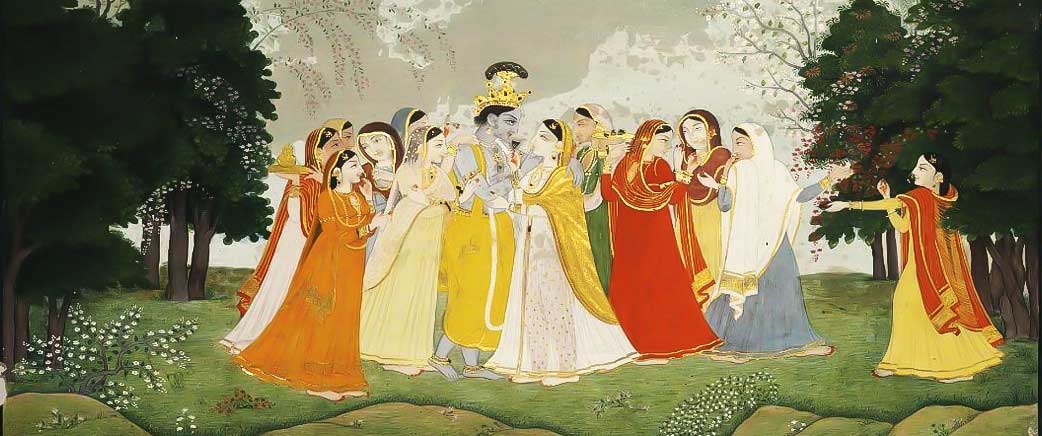
Kangra Paintings: Capturing Divine Love and Natural Splendor on Canvas
Welcome to the realm of Kangra Paintings, an art form that embodies the rich cultural heritage of Himachal Pradesh, a state known as the “Land of the Divine.” Nestled amidst the majestic Himalayas, Himachal Pradesh is a treasure trove of diverse cultures, and each district within the state holds its own unique artistic traditions. Among these, Kangra stands out as a prominent hub for Kangra Paintings, a style that has captivated art enthusiasts for centuries.
With a history dating back to the 18th century, Kangra Paintings have flourished as an exquisite form of art, showcasing the unparalleled beauty of the region. These paintings are characterized by their delicate brushwork, vibrant colors, and intricate detailing, which together create mesmerizing compositions. The themes of Kangra Paintings often revolve around love, nature, mythology, and spirituality, portraying the deep connection between human emotions and the natural world.
Kangra Paintings are named after the Kangra Valley, a gorgeous place in Himachal Pradesh where this art form flourished. The tranquil views of the valley, covered with lush foliage, snow-capped mountains, and flowing rivers, have inspired generations of painters who have attempted to portray the ethereal beauty of their environment on canvas.
It found prominence during the reign of Maharaja Sansar Chand in the 18th century. While its main centers were Bilaspur, Nurpur, Guler, and Kangra, its influence expanded to other regions of India, including Kullu, Suket, and Arki. The patronage of kings and aristocrats played a vital role in nurturing this art form, providing support and recognition to the talented artists. Today, Kangra Paintings continue to be revered for their captivating beauty and intricate craftsmanship, serving as a testament to the artistic legacy of Himachal Pradesh.
We will investigate the techniques used by painters, the meaning buried in their works, and the cultural value that these artworks possess as we dig into the world of Kangra Paintings. Join us on a creative trip as we explore the essence of Kangra Paintings and the depths of its hypnotic beauty.
With a history dating back to the 18th century, Kangra Paintings have flourished as an exquisite form of art, showcasing the unparalleled beauty of the region. These paintings are characterized by their delicate brushwork, vibrant colors, and intricate detailing, which together create mesmerizing compositions. The themes of Kangra Paintings often revolve around love, nature, mythology, and spirituality, portraying the deep connection between human emotions and the natural world.
Kangra Paintings are named after the Kangra Valley, a gorgeous place in Himachal Pradesh where this art form flourished. The tranquil views of the valley, covered with lush foliage, snow-capped mountains, and flowing rivers, have inspired generations of painters who have attempted to portray the ethereal beauty of their environment on canvas.
It found prominence during the reign of Maharaja Sansar Chand in the 18th century. While its main centers were Bilaspur, Nurpur, Guler, and Kangra, its influence expanded to other regions of India, including Kullu, Suket, and Arki. The patronage of kings and aristocrats played a vital role in nurturing this art form, providing support and recognition to the talented artists. Today, Kangra Paintings continue to be revered for their captivating beauty and intricate craftsmanship, serving as a testament to the artistic legacy of Himachal Pradesh.
We will investigate the techniques used by painters, the meaning buried in their works, and the cultural value that these artworks possess as we dig into the world of Kangra Paintings. Join us on a creative trip as we explore the essence of Kangra Paintings and the depths of its hypnotic beauty.

Making Process Of Kangra Paintings
The creation of Kangra Paintings involves a meticulous and elaborate process, requiring skilled artists who possess a deep understanding of the techniques and aesthetics of this art form. Let’s explore the various steps involved in the making of Kangra Paintings:
1. Preparation of The Canvas
Indeed, the canvas used in Kangra Paintings holds great significance and is a defining characteristic of this art form. The choice of canvas plays a crucial role in the overall aesthetic and durability of the artwork. The process begins with the preparation of a specialized canvas. Traditionally, handmade paper or cloth, known as “wasli,” is used as the base for Kangra Paintings. The surface is treated with a mixture of gum arabic and white clay to make it smooth and suitable for painting.
The process of preparing the canvas for Kangra Paintings begins by applying a mixture of Arabic gum and white clay on the canvas. Once this mixture dries, it creates a slightly rough surface. To make the canvas suitable for painting, artists then gently smooth the surface using a stone. This step ensures that the canvas is ready to receive the delicate brushwork and vibrant colors characteristic of Kangra Paintings.
The process of preparing the canvas for Kangra Paintings begins by applying a mixture of Arabic gum and white clay on the canvas. Once this mixture dries, it creates a slightly rough surface. To make the canvas suitable for painting, artists then gently smooth the surface using a stone. This step ensures that the canvas is ready to receive the delicate brushwork and vibrant colors characteristic of Kangra Paintings.
2. Sketching
The artist starts by sketching the outline of the composition lightly using a pencil or charcoal. This step helps in ensuring the correct proportions and placement of the figures and elements within the painting. Mostly the artist sketches nature, mythology, spirituality, and love as they are the main themes in Kangra paintings. The artist first chose the theme and then started working on it.
3. Outlining
When the sketch is finished, the artist uses a fine brush and black ink to outline the main characters and details. This stage is critical because it establishes the painting’s borders and structure. Outlining the sketch allows the artist to fill in the color more correctly. Because Kangra paintings are incredibly detailed, each and every color in this should be excellent. Outlining will be quite beneficial to the artist

4. Color Application
Kangra Paintings are known for their vibrant and harmonious color schemes. The artist begins by applying broad washes of colors to the different areas of the painting, following a sequential order from background to foreground. The colors are typically derived from natural sources, such as minerals, plants, and stones, mixed with water and gum arabic to create a watercolor-like consistency.
5. Fine Detailing
After the initial washes of color have dried, the artist proceeds to add intricate details to the painting. This involves using delicate brushwork to depict facial features, clothing patterns, jewelry, and the finer elements of the composition. The attention to detail is a hallmark of Kangra Paintings, showcasing the artist’s skill and precision.
6. Depiction of Landscapes and Nature
Kangra Paintings often feature lush landscapes, rivers, trees, and flowers as integral elements of the composition. The artist employs techniques like gradation, layering, and texturing to depict the natural elements realistically and evoke a sense of serenity and beauty.
7. Depiction of Emotions and Expressions
Another distinguishing aspect of Kangra Paintings is the portrayal of emotions and expressions. The artists pay close attention to capturing subtle facial expressions, gestures, and body language to convey the intended mood or sentiment of the figures depicted in the painting.

8. Final Touches
Once the painting is complete, the artist may add final touches and embellishments to enhance its aesthetic appeal. This could include the application of gold or silver leaf, highlighting certain areas with metallic colors, or adding decorative patterns and motifs.
The creation of a Kangra Painting demands patience, skill, and a deep appreciation for the art form. It is a labor-intensive process that requires the artist’s unwavering dedication to capturing the essence of beauty, spirituality, and storytelling in every stroke of the brush.
The creation of a Kangra Painting demands patience, skill, and a deep appreciation for the art form. It is a labor-intensive process that requires the artist’s unwavering dedication to capturing the essence of beauty, spirituality, and storytelling in every stroke of the brush.




